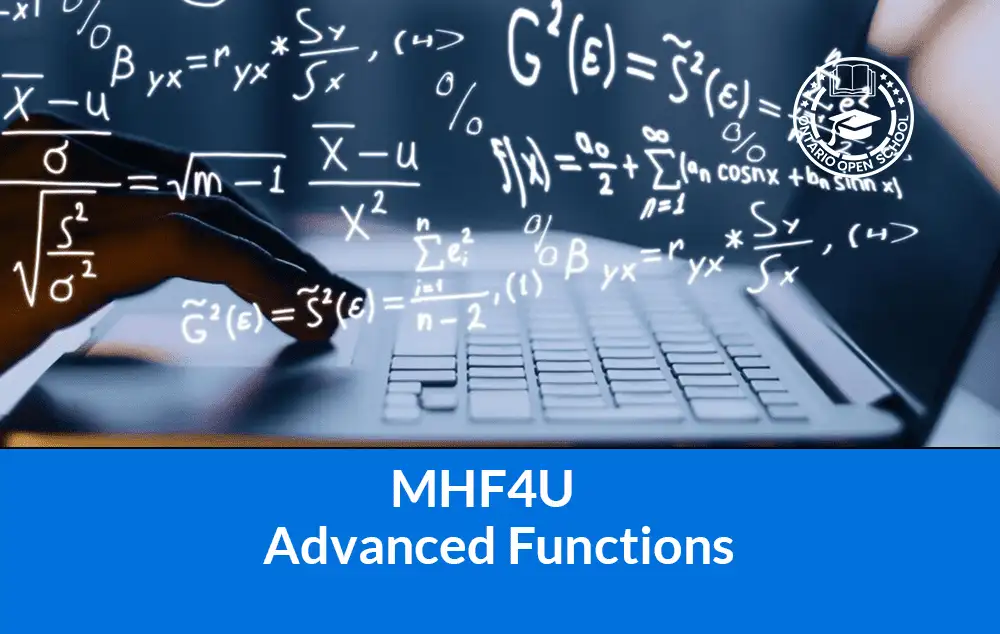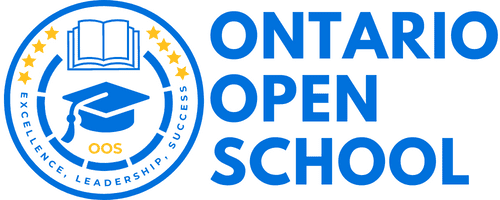- info@ontarioopenschool.com
- 647-494-4499
-
Unit 100 - 29 Gervais Drive, North York, ON.
M3C 1Y9
Copyright 2024 Ontario Open School Inc. All Rights Reserved.
This course extends students’ experience with functions. Students will investigate the properties of polynomial, rational, logarithmic, and trigonometric functions; develop techniques for combining functions; broaden their understanding of rates of change; and develop facility in applying these concepts and skills. Students will also refine their use of the mathematical processes necessary for success in senior mathematics. This course is intended both for students taking the Calculus and Vectors course as a prerequisite for a university program and for those wishing to consolidate their understanding of mathematics before proceeding to any one of a variety of university programs.
Unit Order | Unit Name | Suggested Time |
|---|---|---|
| Unit 1 | Functions: Characteristics and Properties Many situations can be modelled graphically. Interpreting those graphs is something that requires you to become familiar with all of the aspects of these graphs. Students will recall a few basic facts of a distance time graph. In previous math courses, students saw some transformations and studied their effects on a given graph. These will also be reviewed. The concepts of function notation, relation, range, domain, and function notation will all be reviewed. | 10 hours |
| Unit 2 | Polynomial Functions In this unit students learn to identify and describe some key features of polynomial functions and to make connections between the numeric, graphical, and algebraic representations of polynomial functions. Transformations of Cubic and Quartic functions. Dividing and Factoring Polynomials. | 10 hours |
| Unit 3 | Polynomial Equations and Inequalities Solving polynomial equations. Solving linear and polynomial equations by using factoring and graphing | 12 hours |
| Unit 4 | Rational Functions, Equations and Inequalities The concepts of identifying and describing some key features of the graphs of rational functions are also presented. Students will represent rational functions graphically; solve problems involving polynomial and simple rational equations graphically and algebraically so they can demonstrate an understanding of how to solve rational inequalities. | 12 hours |
| Unit 5 | Trigonometric Functions This unit examines the meaning and application of radian measure. Students will make connections between trigonometric ratios and the graphical and algebraic representations of the corresponding trigonometric functions and between trigonometric functions and their reciprocals. Transformations of Trigonometric Functions | 13 hours |
| Unit 6 | Trigonometric Identities and Equations Exploring equivalent trigonometric functions. Compound and Double angle formulas. Proving Trigonometric Identities. Solving linear and quadratic trigonometric equations. | 12 hours |
| Final Evaluation 30% | Final Assignment Final Exam | 6 hours 2 hours |
| Total | 110 Hours |
A wide variety of instructional strategies are used to provide learning opportunities to accommodate a variety of learning styles, interests and ability levels. These strategies include, but are not limited to:
|
Think-Pair-Share Peer Assessment Model Analysis Anticipation Guide Graphing Applications Investigate Research Graphic Organizers
|
Concept Attainment Entry Slip Group Discussion Problem Solving Self-Assessments KWL Chart Direct Instruction Exit card |
Purpose
The primary purpose of assessment is to improve student learning. Assessment relates directly to the expectations for the course.
A variety of assessments for and as learning are conducted on a regular basis to allow ample opportunities for students to improve and ultimately demonstrate their full range of learning and for the teacher to gather information to provide feedback. Assessment tasks relate to the success criteria set out in lesson plans. Success criteria allow students to see what quality looks like.
Evaluation is the process of judging the quality of student work in relation to the achievement chart categories and criteria and assigning a percentage grade to represent that quality. Evaluation is based on gathering evidence of student achievement through:
Assessment for Learning – we provide feedback and coaching. Assessment FOR Learning is the process of seeking and interpreting evidence for the use of learners and their teachers to decide where the learners are in their learning, where they need to go, and how best to go there.
Assessment as Learning – we help students monitor progress, set goals, reflect on their learning
Assessment AS Learning is the process of the explicit fostering of students’ capacity over time to be their own best assessors, but teachers need to start by presenting and modeling external, structured opportunities for students to assess themselves.
Assessment of Learning – we use assessments to provide evaluative statements about student achievement. Assessment OF Learning is the assessment that becomes public and results in statements of symbols
(marks/grades/levels of achievement) about how well students are learning. It often contributes to pivotal decisions that will affect students’ future.
ASSESSMENT TOOLS
| Units | Duration | Overall Expectations | AFL | AAL | AOL | K
25% |
A
25% |
C
25% |
T 25% |
||
| A | 25 hours | A1-A3 | Diagnostic Assessment
Homework Unit Review Practice Test Exit card
|
Reflective Discussion on Learning
|
Unit Assignment Test
Presentation
|
√ | √ | √ | √ | ||
|
70% |
B | 28 hours | B1-B3 | Diagnostic Assessment
Assigned Questions Unit Wrap Up Exit card
|
KWL Chart | Unit Test
Presentation |
√ | √ | √ | √ | |
| C | 36 hours | C1-C4 | Prior Knowledge Assessment Worksheet Unit Review
Unit Wrap Up Discussion Exit card
|
KWL Chart
|
Unit Assignment Test Presentation
|
√ | √ | √ | √ | ||
| D | 21 hours | D1-D3 | Homework
Unit Review Unit Wrap Up Exit card
|
Pair Peer Assessment Assignment | Presentation
Test
|
√ | √ | √ | √ | ||
| 30% | Final Project (A1-D3)
|
Final Evaluation 30% Summative
Final Exam
|
√ |
√ |
√ |
√
|
|||||
These learning skills and work habits will be taught, assessed and evaluated throughout the course.
Responsibility
Fulfils responsibilities and commitments within the learning environment
Completes and submits class work, homework, and assignments according to agreed-upon timelines.
Takes responsibility for and manages own behaviour
Collaboration
Accepts various roles and an equitable share of work in a group
Responds positively to the ideas, opinions, values, and traditions of others
Builds healthy peer-to-peer relationships through personal and media-assisted interactions
Works with others to resolve conflicts and build consensus to achieve group goals
Shares information, resources, and expertise, and promotes critical thinking to solve problems and make decisions
Organization
Devises and follows a plan and process for completing work and tasks
Establishes priorities and manages time to complete tasks and meet goals
Identifies, gathers, evaluates, and uses information, technology, and resources to complete tasks
Self- Regulation
Sets own individual goals and monitors progress towards achieving them
Seeks clarification or assistance when needed
Assesses and reflects critically on own strengths, needs and interests
Identifies learning opportunities, choices, and strategies to meet personal needs and meet goals
Perseveres and makes an effort when responding to challenges
Independent Work
Independently monitors, assesses, and revises plans to complete tasks and meet goals
Uses class time appropriately to complete tasks
Follows instructions with minimal supervision
Initiative
Looks for and acts on new ideas and opportunities for learning
Demonstrates the capacity for innovation and a willingness to take risks
Demonstrates curiosity and interest in learning
Approaches new tasks with a positive attitude
Recognizes and advocates appropriately for the rights of self and others
E – Excellent G – Good S – Satisfactory N – Needs Improvement
Resources
Grading
Weighting of categories
| Knowledge/Understanding | Thinking/Inquiry | Communication | Application |
| 25% | 25% | 25% | 25% |

Course Grade | Grade 12 |
|---|---|
Course Code | MHF4U |
Course Category | Mathematics |
Course Type | University Preparation |
Course Delivery | Online |
Course Duration | 110h |
Course Credit | 1.00 |
Copyright 2024 Ontario Open School Inc. All Rights Reserved.
